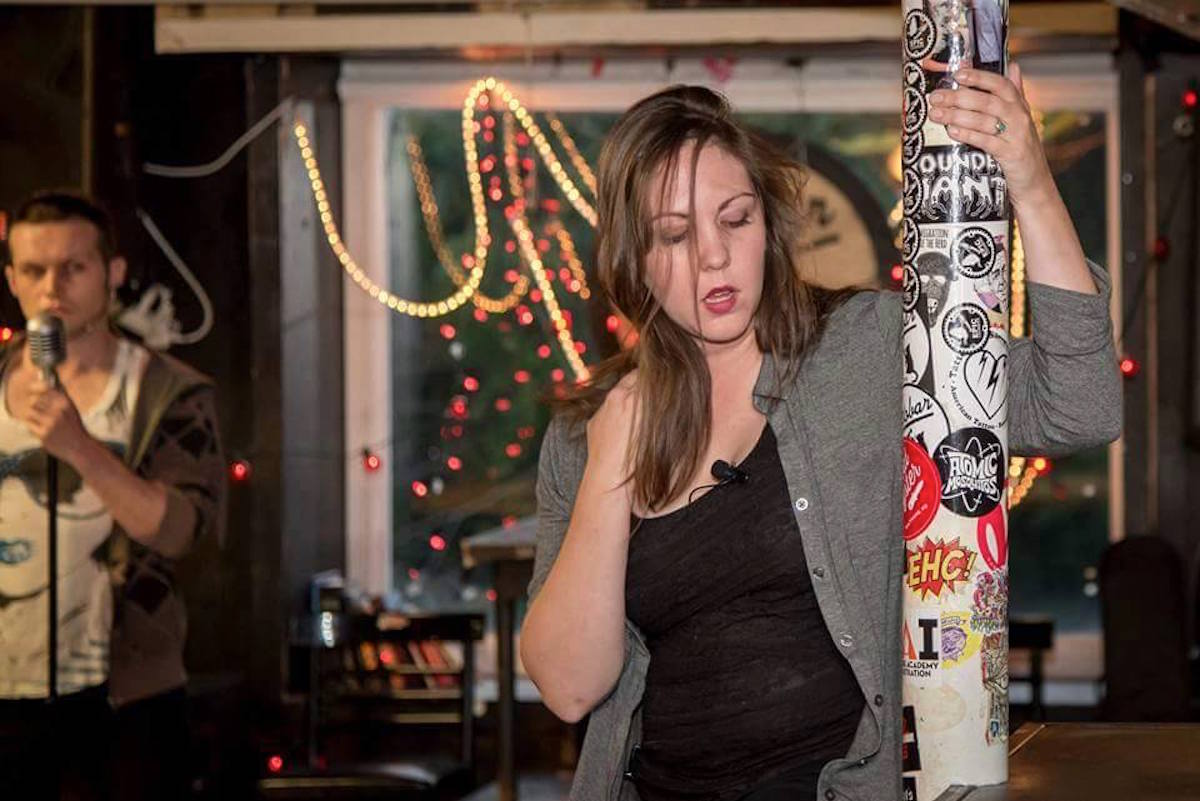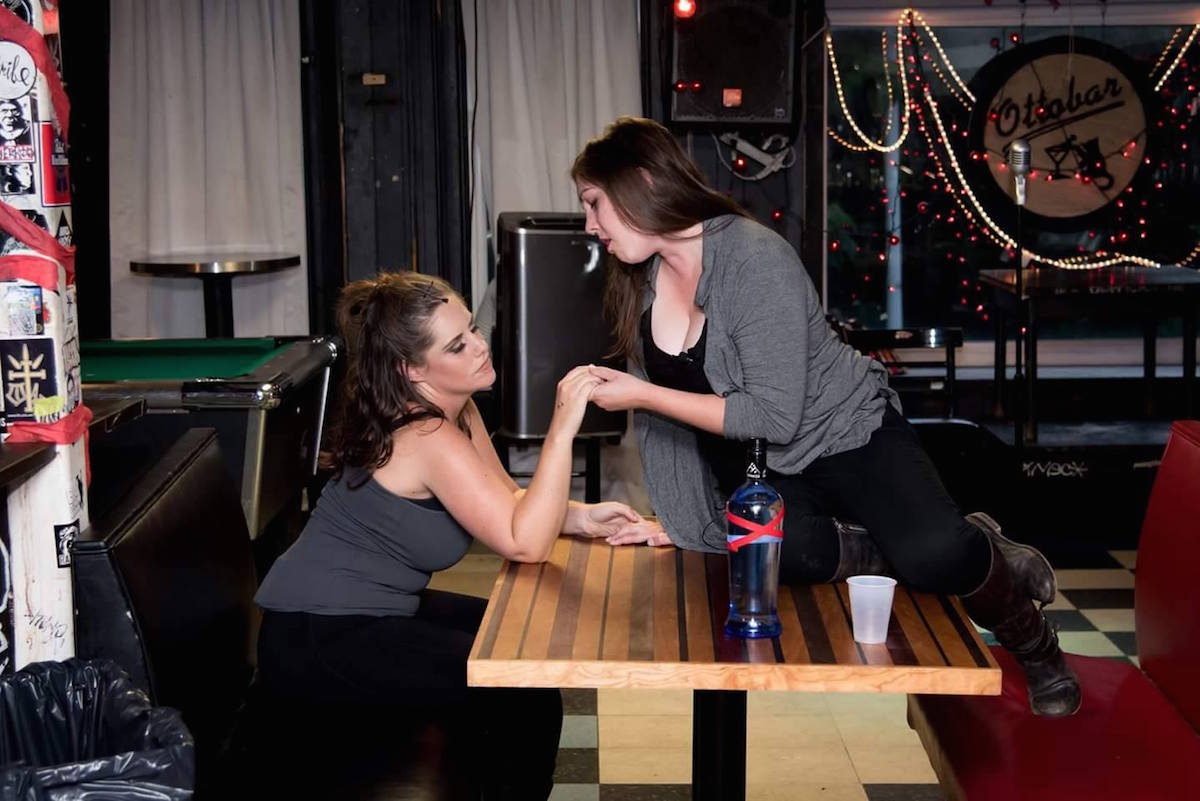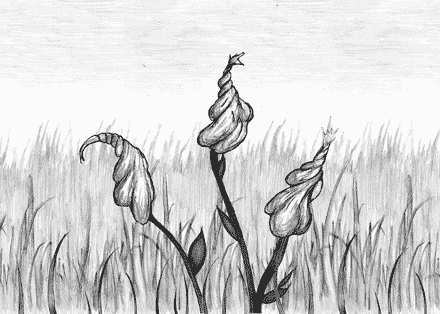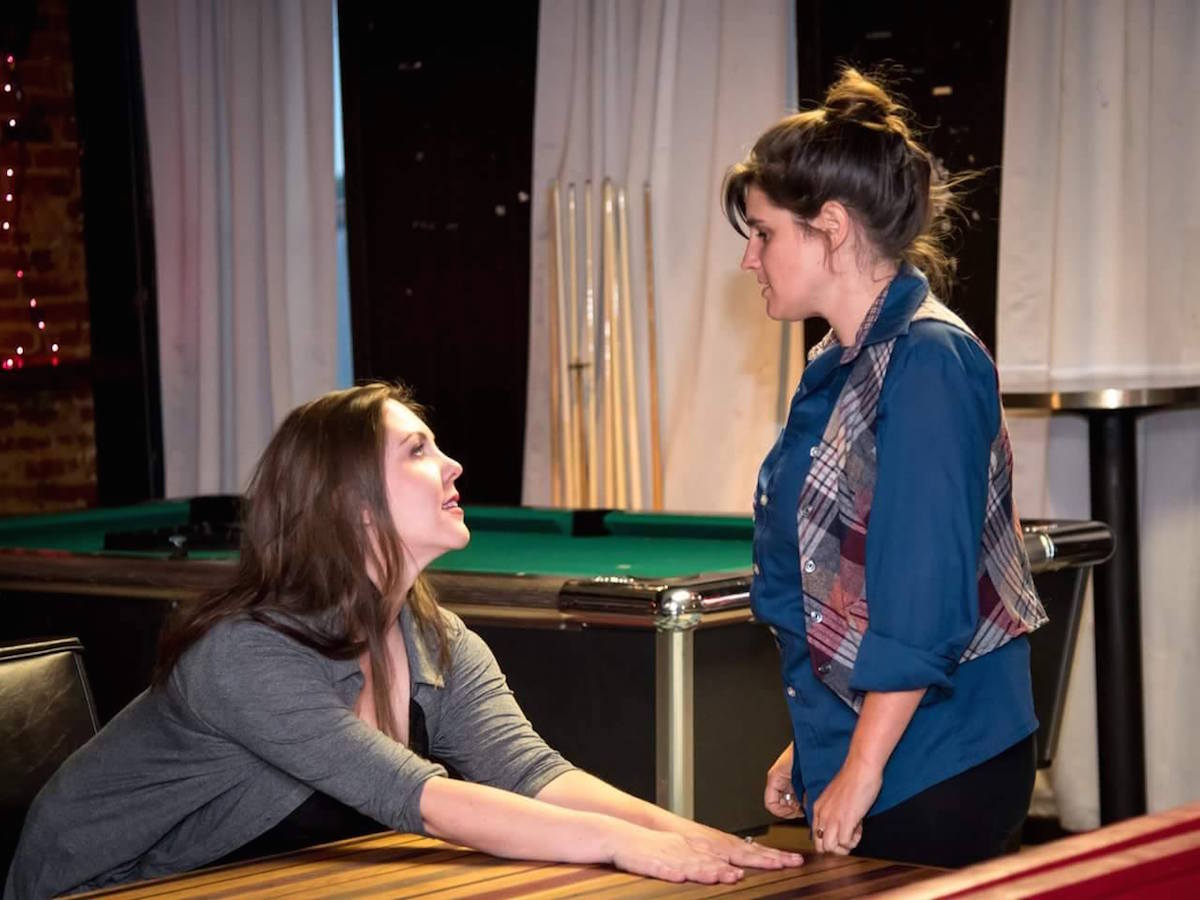Last weekend to catch Stillpointe Theater’s winningly raw Murder Ballad
By Bret McCabe
The love life of Sarah (Sarah Heiderman) is totally on the ups.
After tumbling out of a turbulent relationship with the black-leather-jacket-wearing bartender Tom (Amber Wood), this music-loving, fast-living, curves-in-all-the-right-places do-right woman meets the scholarly sweet Michael (Moira Horowitz), a poetry PhD who appears to be falling head over heels for her even before he’s got her on her back. First comes love, then comes marriage, and, yes, there comes Sarah with a baby carriage.
This courtship takes place in New York City, the Big Apple, the kind of topsy-turvy place where a gal who once liked to party-as-a-verb below 14th Street one days wakes up and finds herself living on the Upper West Side. She has to take her daughter to school. Meet with teachers. Enjoy a single glass of white wine with dinner. Her life becomes this fantasy of suffocating stability. Wasn’t she once able to drive a man so wild with lust he tried to paw through her clothes in public? Hmm, perhaps she can accidentally run into bad boy Tom at his old watering hole…
 Sara Hinderman
Sara Hinderman
Welcome to Stillpointe Theater‘s wonderfully gritty production of Murder Ballad, playwright Julia Jordan and singer/songwriter Juliana Nash’s rock opera-qua-immersive musical that consistently sold out New York’s Manhattan Theater Club’s studio space and Union Square Theatre when it debuted in 2013.
It’s a tightly scripted, roughly 80 minute dive into somebody done somebody wrong song. And, as promised by the title, somebody’s gonna die tonight. As conceived and interpreted by Stillpointe—directed by Corey Hennessey, co-directed by Amanda Rife, and with a production/design team of Ryan Haase, Zoe Kanter, and Danielle Robinette—Murder plays out like an alcohol-fueled, last-call soap opera at the Ottobar, primarily because it’s performed in the North Howard Street music venue’s second-floor bar-cum-pool hall and intimate live stage.
That’s right: this is theater in the indie-rock dive-bar round, and the approach only amplifies the musical’s tawdry commonness. I don’t mean that as a knock against either Jordan and Nash’s music and lyrics nor Stillpointe’s approach, because both recognize the everyday horror of this story. Seriously: how many cable TV docudrama episodes and true-crime-leaning news magazines feature stories that involve murder among married couples or people in a relationship—”intimate partner,” in the cold language of homicide statistics?
A 2012 Bureau of Justice Statistics report claims that from 1993 to 2008, among homicides reported to the FBI for which the victim-offender relationship was known, “between 73% and 79% were committed by offenders known to the victims.” Murder in America is way too often carried out among people acquainted with each other, and we love it when it’s turned into pop entertainments—which, as the title also alludes to, is something Americans have been doing since Europeans stole the land.
 Amber Wood and Sara Hinderman
Amber Wood and Sara Hinderman
Reductively speaking, a “murder ballad” is a song form brought over from Europe that, as filtered through popular 17th and 18th-century British and Scottish songs, evolved into the particularly American murder ballad of the 19th century, with key examples found in Appalachian folk and the blues. The ghosts of those songs—see: the Blue Sky Boys’ version of “Down On The Banks of the Ohio” that was included on Harry Smith’s Anthology of American Folk Music, Volume Four—haunt 20th-century bluegrass, country, folk, and pop music.
The ethnomusicology of the murder ballad is far richer, more varied, and less Anglo-centric than explained here—see also: oh, the operatic murders detailed in sumptuously melodramatic narcocorrido songs—but this version permits us to think about the murder ballad as music writing often does: as mere niche genre. Hence lists that detail the bloodiest, creepiest, grisliest, and most disturbing murder ballads.
Jordan and Nash’s creative coup is returning the murder ballad to its common people vernacular. Yes, sometimes the entirely sung dialogue here often flits around at the brisk sing-speak pace common to musical theater, but musically—a quick shout out to music director Nick Jewett and the production’s rock quartet of Jewett (guitar), Joe Pipkin (drums), Cody Raum (bass), Trevor Shipley (keys)—Murder Ballad is straight up contemporary pop-40 radio rock and its hybrids. Any one of these songs wouldn’t feel out of place in a mall clothing store’s piped-in music playlist, which has the musical effect of making the production feel like it could take place in a cheesy 1980s or ’90s rom-com musical montage, right down to the sometimes clichéd lyrics and clumsy rhymes.
Michael and Sarah’s attraction is too fast for love. Sarah and Tom’s affair gives love a bad name. When she comes home you feel that Michael can barely restrain himself from asking, Why’d ya do it?. They spend their time together walking on a wire. One song toward the end opens with a two chord guitar figure that splits the difference between the bass lines in Lou Reed’s “Walk on the Wild Side” and Buffalo Springfield’s “For What It’s Worth,” and the whisper of the allusion alone musically suspends Sarah between decadence and agitation.
 Moira Horowitz, Corey Hennessey, and Sara Hinderman
Moira Horowitz, Corey Hennessey, and Sara Hinderman
All of which makes Stillpointe’s choice of staging this musical so entertaining: you can sit at the bar or a few tables and the action unfolds around you. Director Hennessey pulls double duty as the narrator, singing the production’s scene-setting opening number and impishly directing the players throughout, gesturing them into places about the room and offering the props they might need: a bottle of booze to drown sorrows, a baseball bat to unleash hell. He’s a devilish figure, the guy who lets us all now that we’re sitting down for a “tale where good does not prevail,” and he’s just waiting for us to find out what he already knows.
And while this production cast female performers for the male characters Tom and Michael, neither Wood nor Horowitz treats the roles as women-playing-men drag and they smartly don’t switch the gender of the pronouns in the lyrics. They just inhabit who these people are: Wood’s Tom swaggers through the room and grabs Sarah like the kind of ex who knew she’d eventually be back one day. Horowitz, clad in a nebbish plaid vest, is the thoughtful and vulnerable foil to the Tom’s firm and callous hand. Heiderman at first makes Sarah a woman who pinballs between them as if searching for the version of herself she recognizes.
In some ways Murder Ballad is the story of Sarah figuring out what she wants. And once she finally does, the musical tightens its tensions, and kudos to co-directors Hennessey and Rife for guiding the cast into the genuinely chilling. The musical recognizes that actual violence between intimate partners is overwhelmingly preceded by emotional and interpersonal violence, and words draw the most blood here. And, wouldn’t you know it, it’s the poet-educated Michael who delivers some of the evening’s most brutal lines.
Who eventually kills whom here is almost anticlimactic compared to how disturbingly familiar the road there is. And by interpreting these characters almost generic stereotypes Stillpointe spotlights how unacceptably frightening it is that the homicidal love triangle is common enough to be a narrative trope.
So come now, and hear the tale of Sarah, Tom, and Michael as they join the ranks of singers who wondered where Joe’s going with that gun in his hand, who singed letters as your biggest fan, and who immortalized all the Frankies in this world who are just trying to survive.
*****
Author Bret McCabe is a haphazard tweeter, epic-fail blogger, and a Baltimore-based arts and culture writer.
Murder Ballad runs through September 17, 2016. For tickets and information, click here.
Photos by Rob Clatterbuck / clatter photo
Top Image: Sara Hinderman (left) and Moira Horowitz






